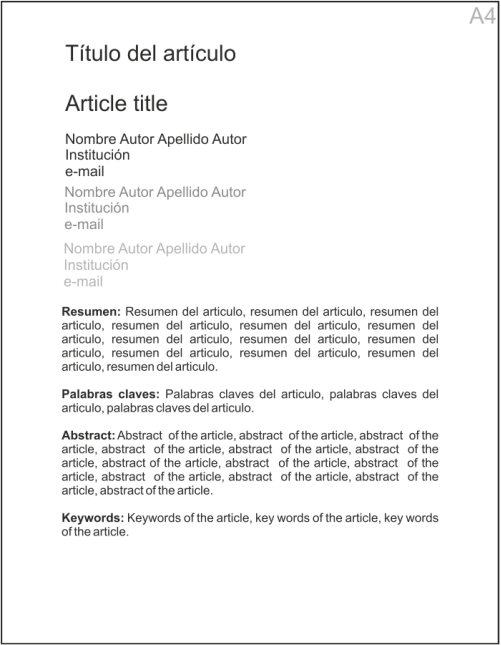Publication Rules
FORMAT OF THE ACT / ARTICLE

WORK ORGANIZATION
The articles will have the following parts: Title in Spanish, Title in English, authors, institutional membership for each author, email address, summary in Spanish, keywords in Spanish, abstract in English, keywords in English, text of the work (introduction, development , conclusions), bibliographic list, acknowledgments (if applicable).
The name of the authors will be indicated, without degrees or titles, according to: first name and surname (s).
Summary: it must not exceed 150 words in the Spanish version and the corresponding amount in the English version. You must present precisely the content of the work described in a simple and direct way. You must establish objectives and scope of the study conducted describing in a synthetic way the methodology, a summary of results and the main conclusions. It should not contain information or conclusions that are not included in the article. Do not use abbreviations or cite references, except for strict exceptions.
Keywords: Three to five keywords (keywords) that allow a potential user to identify the article in international databases should be included. Authors should define them among those that they believe will be more suitable for this purpose. Generally those words that are chosen as keywords will also appear in the title of the article or, at least, in the abstract.
Formulas: Mathematical formulas and expressions should be separated from text paragraphs by a blank space. The same spacing will be respected between each of them if several must be listed in succession. They will be presented in Math Type and, if not possible, in Word. Avoid presenting them in jpg format. The formulas will be adjusted to the left margin of the column and will be numbered correlatively and in parentheses at the right end of the corresponding line. The meaning and the units used in each term of the expressions must be perfectly defined. The use of the International System of Units (SI) is recommended. If it is considered convenient, the values of other units or conversion factors may be entered in parentheses. Figures and graphics: The figures will be numbered consecutively in order of appearance in the text and will include a brief explanatory title at the bottom (Ex .: Figure 1. Experimental data of calorific capacities of liquids.). If it is necessary to include photos, they should be designated as figures. They must be presented with good definition. They must be inserted in the corresponding place between the text and must also be sent as attachments (complementary) in JPG format and web quality. Graphics should be inserted as figures (JPG). Tables: Tables will be numbered consecutively independently of the figures and according to the order of appearance in the text including an explanatory title at the bottom (Ex .: Table 1. Population distribution data.) Leaving a space between the heading and the following text. The legends of the axes should be clear and precise. For the ordinate axis they will be placed vertically from the bottom up and for the abscissa horizontally from left to right.
CITATION AND BIBLIOGRAPHIC LISTINGReferences: The term Bibliography should not be used as a synonym for References. In the text of the work they will be cited by author, year and page / s cited in parentheses (Ahmad and Barton, 1997: 15-16). When there are more than two authors, the first author will be cited, followed by et al. (Chang et al., 1999). In the bibliographic list (at the end of the article) all references cited with the full name of the authors must be mentioned in alphabetical order and without numbering according to the APA standards format:Journal articles: Author's last name, Name initial (year of publication in parentheses). "Full title of the article in quotes", full name of the magazine in italics, volume, number in parentheses (if applicable), the start and end numbers of the article separated by hyphen. Example: Eckert, C. and Sherman, S. (1996). "Measurement and Prediction of Limiting Activity Coefficients", Fluid Phase Equilibria, 116, 333-342.Books: In this case you must also indicate the city in which it was published, the publishing house. Example: Boyce, W. and Di Prima, R. (1997). Elementary Differential Equations and Boundary Value Problems. New York: John Wiley & Sons, 169-204.Thesis: To cite them, the following detail must be indicated: author, title, mention of the thesis (indicate the degree that has been reached in parentheses), institution, place, number of pages and date of publication in parentheses. Example: Ahmad, B. S. (1997). "Synthesis of Batch Processes with Integrated Solvent Recovery", Thesis (Ph. D. in Chemical Engineering), Massachusetts Institute of Technology, Massachusetts.Conference Proceedings: They should be cited according to the format established for magazine articles but replacing the name of the publication with the one corresponding to the event, in addition to the place and date of realization. Example: Valderrama, O. and Roselló, A. (1996). “Application of the Chemcad-Batch Simulator to Wine Distillation”, Proceedings of the 3rd Inter-American Congress of Computing Applied to the Process Industry, CAIP´96, Villa María, Argentina, November 12-15, 229-232.









